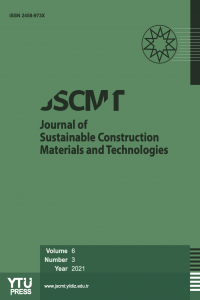Mechanical behavior of large-diameter pipe elbows under low-cyclic loading
Mechanical behavior of large-diameter pipe elbows under low-cyclic loading
___
- Vazouras, P., & Karamanos, S. A. (2017). Structural behavior of buried pipe bends and their effect on pipeline response in fault crossing areas. Bulletin of Earthquake Engineering, 15, 4999-5024.
- Vathi, M., Karamanos, S. A., Kapogiannis, I. A., & Spiliopoulos, K. V. (2017). Performance criteria for liquid storage tanks and piping systems subjected to seismic loading. Journal of pressure vessel technology, 139(5), 051801. [CrossRef]
- Kim, S. W., Jeon, B. G., Hahm, D. G., & Kim, M. K. (2023). Failure criteria evaluation of steel pipe elbows in nuclear power plant piping systems using cumulative damage models. Thin-Walled Structures, 182, 110250. [CrossRef]
- Varelis, G. E., Karamanos, S. A., & Gresnigt, A. M. (2013). Pipe elbows under strong cyclic loading. Journal of Pressure Vessel Technology, 135(1), 011207. [CrossRef]
- Daliri, A. K., & Naimi, S. (2016). Dynamic analysis of fixed marine risers with 1st and 5th order Rogue Waves. Journal of Engineering Research, 4(3), 43-56.
- Daliri, A. K., & Naimi, S. (2018). Transient dynamic analysis of the high-specific-strength steel jacket with extreme wave and vessel impact load. Acta Scientiarum. Technology, 40. [CrossRef]
- Futura Sciences. (2023). Sustainable development. Gas pipeline. http://www.futura-sciences.us/dico/d/sustainable-development-gas-pipeline-50000943/
- Hydrocarbons Technology. Midship Natural Gas Pipeline. (2023). https://www.hydrocarbons-technology.com/projects/midship-natural-gas-pipeline-oklahoma-usa/
- Sobel, L. H., & Newman, S. Z. (1980). Comparison of experimental and simplified analytical results for the in-plane plastic bending and buckling of an elbow. J Pressure Vessel Technology, 102, 400-409. [CrossRef]
- Suzuki, N., & Nasu, M. (1989). Non-linear analysis of welded elbows subjected to in-plane bending. Computers & Structures, 32(3-4), 871-881. [CrossRef]
- Chattopadhyay, J., Nathani, D. K., Dutta, B. K., & Kushwaha, H. S. (2000). Closed-form collapse moment equations of elbows under combined internal pressure and in-plane bending moment. J. Pressure Vessel Technol., 122(4), 431-436. [CrossRef]
- Karamanos, S. A., Tsouvalas, D., & Gresnigt, A. M. (2006). Ultimate bending capacity and buckling of pressurized 90 deg steel elbows. Journal of Pressure Vessel Technology, 138(4), 041203. [CrossRef]
- Takahashi, K., Tsunoi, S., Hara, T., Ueno, T., Mikami, A., Takada, H., & Shiratori, M. (2010). Experimental study of low-cycle fatigue of pipe elbows with local wall thinning and life estimation using finite element analysis. International Journal of Pressure Vessels and Piping, 87(5), 211-219. [CrossRef]
- Karamanos, S. A. (2016). Mechanical behavior of steel pipe bends an overview. Journal of Pressure Vessel Technology, 138(4), 041203. [CrossRef]
- Yoshizaki, K., O’Rourke, T. D., & Hamada, M. (2003). Large scale experiments of buried steel pipelines with elbows subjected to permanent ground deformation. Structural Engineering/Earthquake Engineering, 20(1), 1-11. [CrossRef]
- Cheong, T. P., Soga, K., & Robert, D. J. (2011). 3D FE analyses of buried pipeline with elbows subjected to lateral loading. Journal of Geotechnical and Geoenvironmental Engineering, 137(10), 939-948. [CrossRef]
- Kaya, E. S., Uçkan, E., O'Rourke, M. J., Karamanos, S. A., Akbas, B., Cakir, F., & Cheng, Y. (2017). Failure analysis of a welded steel pipe at Kullar fault crossing. Engineering Failure Analysis, 71, 43-62. [CrossRef]
- Kaya, E. Ş. (2023). Eksenel basınç kuvveti ve eğilme momentine maruz çelik boruların performans kriterlerinin saptanması. Gazi Üniversitesi Mühendislik Mimarlık Fakültesi Dergisi, 38(4), 2107-2118. [CrossRef]
- Uckan, E., Akbas, B., Kaya, E.S., Cakir, F., Cengiz, I., Makaraci, M., & Ataoglu, S. (2016). Design issues of buried pipelines at permanent ground deformation zones. Disaster Science and Engineering, 2(2), 53-58.
- Kaya, E. S., Uckan, E., Cakir, F., & Akbas, B. (2016). A 3D nonlinear numerical analysis of buried steel pipes at strike-slip fault crossings. Građevinar, 68(10), 815-823.
- Simulia. (2014). ABAQUS Theory Manual, Version 6.14, Dassault Systèmes.
- Lim, K. S., Azraai, S. N. A., Yahaya, N., Noor, N. M., Zardasti, L., & Kim, J. H. J. (2019). Behaviour of steel pipelines with composite repairs analysed using experimental and numerical approaches. Thin-Walled Structures, 139, 321-333. [CrossRef]
- ALA. (2005). American Lifelines Alliance Guidelines for the Design of Buried Steel Pipe. https://www.americanlifelinesalliance.com/pdf/Update061305.pdf.
- D.G. Honegger, & D.J. Nyman. (2004). Guidelines for the seismic design and assessment of natural gas and liquid hydrocarbon pipelines, prepared for the Pipeline Design Construction & Operations Technical Committee of Pipeline Research Council International, Inc., Catalog No. L51927. [CrossRef]
- Gresnigt, A.M. (1986). Plastic design of buried steel pipelines in settlement areas, HERON, 31(4), 1-113.
- Başlangıç: 2016
- Yayıncı: Yıldız Teknik Üniversitesi
Şevket Onur KALKAN, Lütfullah GÜNDÜZ
Performance of Superabsorbent Polymer as Admixture in Hollow Concrete Blocks
Phoebe Love CANDANO, Kate Rose ELORDE, Irl Rica Ann MEJOS, Rhoe James CABADA, Val Irvin MABAYO
Assessment of a new rigid wall permeameter for the slurry like barrier materials: zeolite example
An architectural query of Anthropocene Era: Planned obsolescence
Mechanical behavior of large-diameter pipe elbows under low-cyclic loading
Oluwafemi AKANDE, Chioma EMECHEBE, Jonam LEMBİ, Joy NWOKORİE
Hussaini MATO, Yahaya Hassan LABARAN, Dipanjan MUKHERJEE, Gaurav SAİNİ, Mahmoud Murtala FAROUQ
